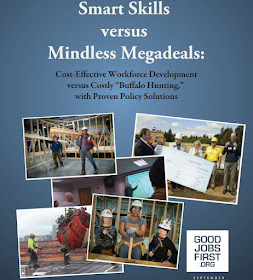Report: Training
Programs Cost Far Less per Job than "Megadeals"
Greg LeRoy
States and localities are spending an average of more than
$658,000 per job on economic development "megadeals" upon which
taxpayers can never break even. And despite such astronomical costs, some
megadeals fail to deliver and sustain jobs.
By contrast, most workforce development programs cost only a
few thousand dollars per job, and studies find they pay off well.
Public officials should quit "buffalo hunting" for
risky megadeals and instead invest in skills, infrastructure, clusters and
entrepreneurs to reduce taxpayer risk and obtain better returns.
The study draws heavily from Good Jobs First's unique Subsidy
Tracker database, which now spans more than 500,000 deals in more than 740
federal, state and local economic development subsidy programs.
The study draws sharp distinctions between low-cost,
low-risk workforce development programs and extremely high-cost
"megadeals" involving economic development subsidies worth hundreds
of thousands and even millions of dollars per job.
Indeed, 14 named megadeals each cost more than $2 million
per job. By contrast, 31 of 33 workforce development programs with available
data cost less than $10,000 per job.
Also detailed are 19 state and two federal programs that cap
the amount of subsidy per job, as well as European "aid intensity"
rules that reduce costs.
"States and localities should put their buffalo muskets
in a museum where they belong. We can spend less and get more," said Greg
LeRoy, executive director of Good Jobs First and co-author of the study.
